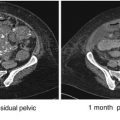Study
n
% optimal primary surgery
% optimal interval surgery
PFS primary
PFS interval
OS primary
OS interval
EORTC [15]
319
0
45 %
13 months
18 months
20 months
26 months
GOG [16]
550
0
?
10.7 months
10.5 months
35.7 months
36.2 months
Table 3.2
Neoadjuvant trials. Results in patients with advanced disease
Study | n | % optimal primary surgery | % optimal interval surgery | PFS primary surgery | PFS interval surgery | OS primary surgery | OS interval surgery |
|---|---|---|---|---|---|---|---|
EORTC [17] | 670 | 41.6 % | 80.2 % | 12 months | 12 months | 29 months | 30 months |
Chorus [18] | 552 | 41 % | 73 % | 10.7 months | 12 months | 22.6 months | 24.1 months |
A consensus exists to recommend primary surgery in patients with good performance status and limited disease (stage IIIa, IIIIb, and IIIc with largest metastasis <50 mm of the 1988 FIGO classification) [25]. This population accounts for 37 % of the overall population.
On the other hand, a minority of patients require a neoadjuvant chemotherapy due to poor general status and/or stage IV disease or large abdominal metastases.
The “grey zone” is now the most challenging population. Patients with good performance status and stage III disease associated with metastases ≥50 mm can be managed by primary surgery (with a real risk of incomplete resection and morbidity) or neoadjuvant chemotherapy and interval surgery. This accounts for 8–25 % of patients. The attitude greatly varies between centers and is mostly a question of philosophy rather than the result of scientific data. The TRUST trial which will compare OS after primary vs. interval debulking surgery in trained centers will address this issue [26]. Overall, the rate of neoadjuvant chemotherapy should not be superior to 30 % of patients.
A different way of thinking has to be used for histology types other than high-grade serous ovarian cancer, especially in types where a low response to chemotherapy is expected. The prevailing strategy may be primary surgery, even in case of expected residual disease.
Selection of patients is today mostly performed using imaging, laparoscopy (see specific chapter), and surgeon’s opinion. However, in the near future, molecular data could be used to help in the decision-making process [27]. It appears logical to propose surgery when the expected rate of complete resection is high and to have an adapted approach in patients with predictable chemoresistance. Today, BRCA mutation and homologous recombination deficiency signature, as well as tumor infiltrating lymphocytes CD8+ expression, should be helpful to predict chemotherapy response and will be more and more taken into account for primary or interval surgery decision. Complex molecular signatures associated to survival have also been published, with better accuracy than classical prognostic factors, to select high- and low-risk patients [27]. The same train of thought has been applied to select patients with the goal of “optimal surgery.” Interestingly, hyperactivation of the TGF-β/Smad pathway and of the RTK/Ras/MAPK/Egr-1 (+ AMPK/Egr-1, Hedgehog/Gli) pathway are associated with tumor dissemination, migration, invasion, angiogenesis, metastatic colonization, and activation of tumor-associated fibroblasts [27].
Conclusion
Several randomized trials have allowed to accumulate data on the surgical management of advanced epithelial ovarian. Complete resection of the peritoneal disease should be the goal of primary or interval debulking surgery. The choice between these two strategies should be done by trained and structured teams. Patients with good general status and low to intermediate extent of disease should be proposed for primary surgery. Patients with poor general status or very extensive disease should be candidates to neoadjuvant chemotherapy. For other patients, the choice between these two options is today mainly a question of opinion. Tomorrow, the TRUST trial will hopefully help to answer this question. We should keep in mind the survival benefit obtained by management of patients by experienced teams and the respect of guidelines.
Personalized approach taking into account molecular characteristics of the tumor will probably help the decision in the future.
References
1.
Griffiths CT. Surgical resection of tumor bulk in the primary treatment of ovarian carcinoma. Natl Cancer Inst Monogr. 1975;42:101–4.PubMed
2.
Chéreau E, Rouzier R, Gouy S, Ferron G, Narducci F, Bergzoll C, Huchon C, Lécuru F, Pomel C, Daraï E, Leblanc E, Querleu D, Morice P. Morbidity of diaphragmatic surgery for advanced ovarian cancer: retrospective study of 148 cases. Eur J Surg Oncol. 2011;37:175–80.CrossRefPubMed
Stay updated, free articles. Join our Telegram channel

Full access? Get Clinical Tree






